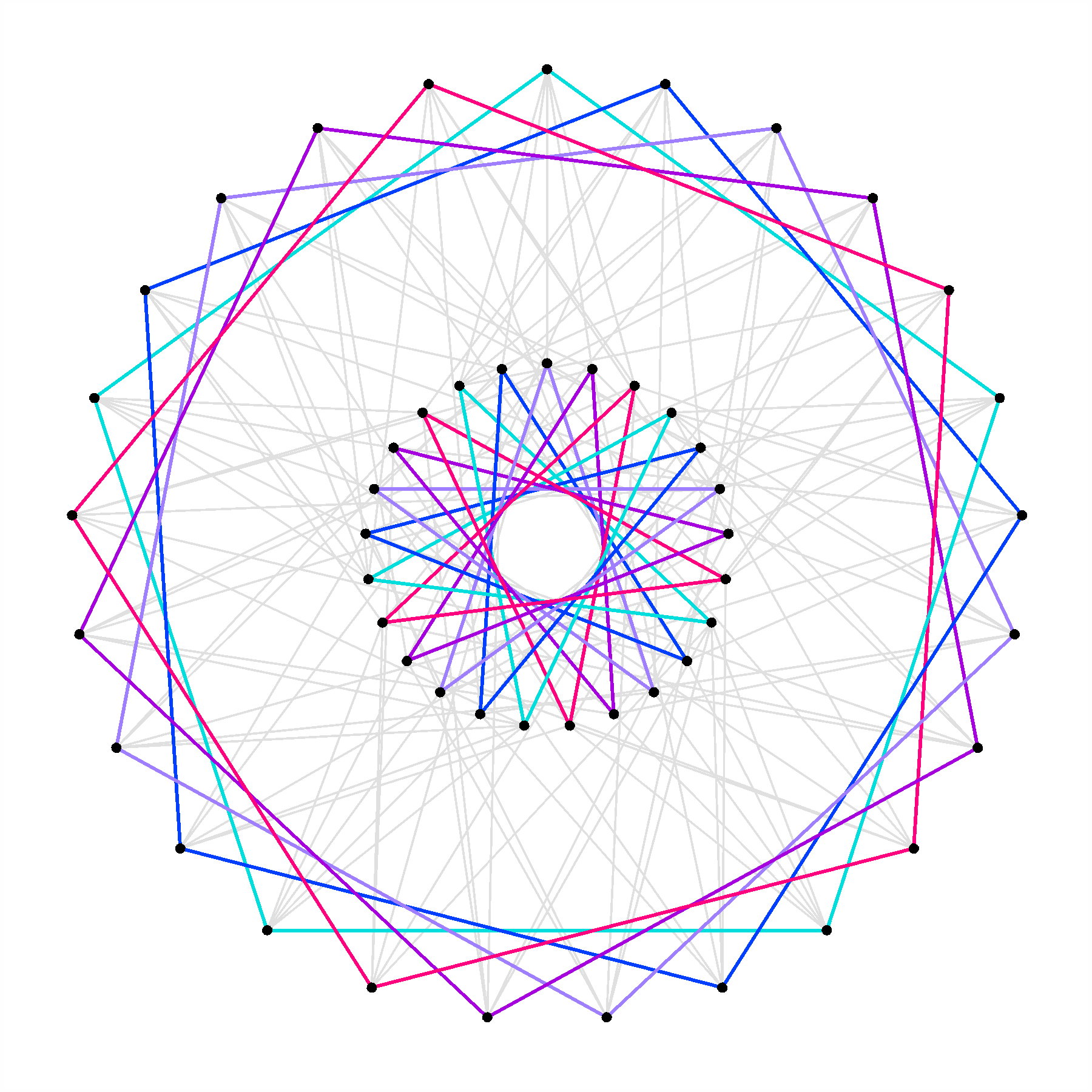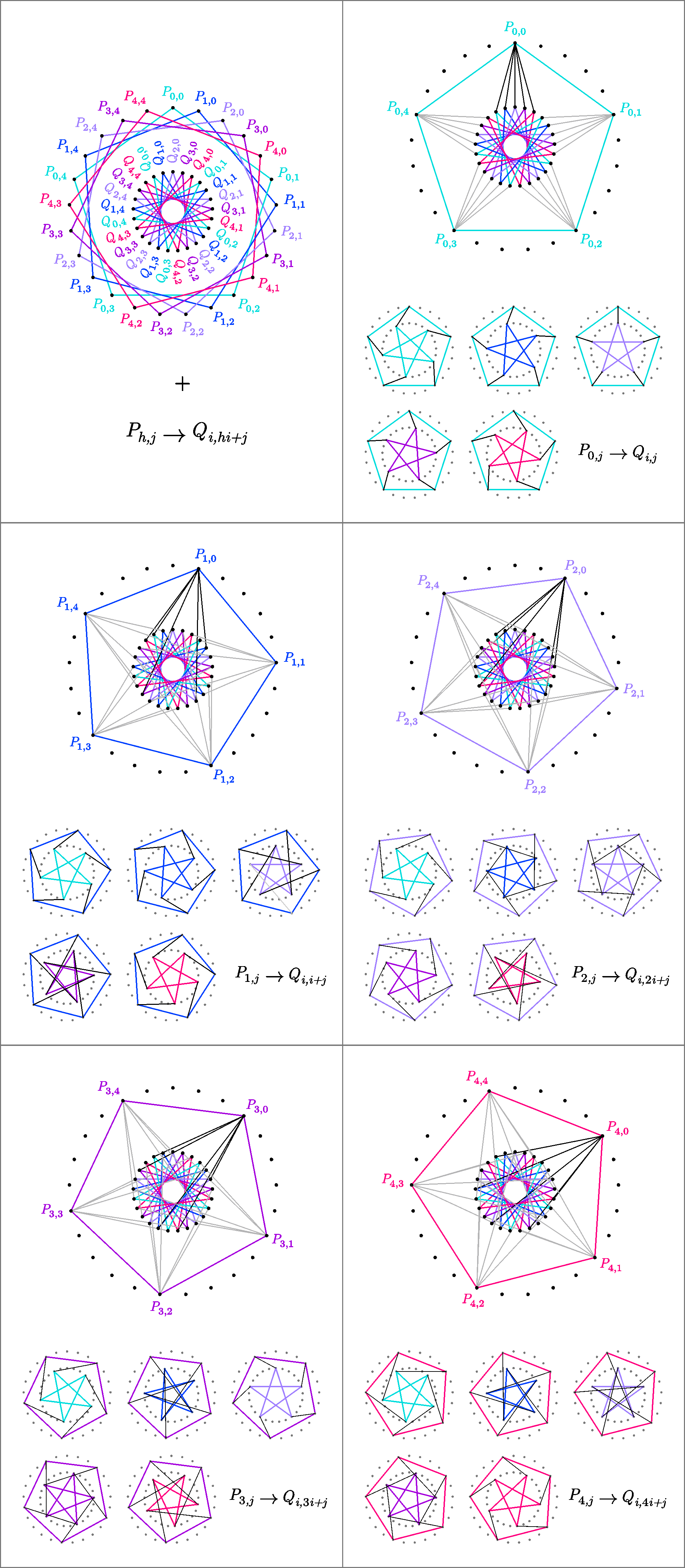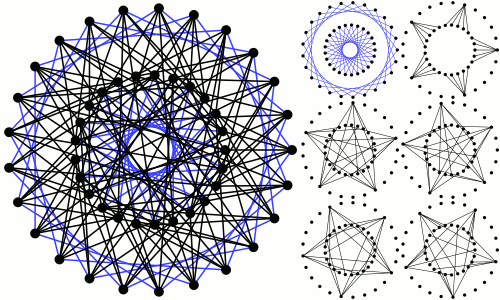This is the Hoffman–Singleton graph, a remarkably symmetrical graph with 50 vertices and 175 edges. There is a beautiful way to construct the Hoffman–Singleton graph by connecting 5 pentagons to 5 pentagrams.
In what follows, all indices lie in Z/5: that is, the integers mod 5.
Take five pentagons Ph: graphs with 5 vertices such that vertex j is adjacent to vertices j−1 and j+1. Take 5 pentagrams Qi: graphs with 5 vertices such that vertex j is adjacent to vertices j−2 and j+2. Now join each vertex j of pentagon Ph to the vertex hi+j of pentagram Qi. The result is the Hoffman–Singleton graph.
Félix de la Fuente constructed the above picture of the Hoffman–Singleton graph using this method. He explains the details here:
In this diagram Ph,j is the jth vertex of the pentagon Ph, while Qi,k is the kth vertex of the pentagram Qi. Each vertex Ph,j is connected to 5 vertices Qhi+j. Félix de la Fuente shows how this connects each pentagon to all 5 pentagrams, forming 5 copies of the ‘Petersen graph’. For more on the Petersen graph, see this earlier post:
Here is another image of the same construction:
The Hoffman–Singleton graph has 252,000 symmetries. Not surprisingly, they’re deeply connected to the math you can do with the numbers 5 and 25. They form a group isomorphic to the group called PΣU(3,F25).
To understand this group, note that F25, the field with 25 elements, can be obtained from F5, the field with 5 elements, by adjoining a square root i of some element that does not have a square root in F5. This element will then have 2 distinct roots in F25, namely i and −i, and there is an automorphism of F25 that exchanges them, called the Frobenius automorphism. This automorphism also sends each element of F25 to its 5th power.
Since it switches i and −i, the Frobenius automorphism of F25 is similar to complex conjugation. We can use it to define unitary matrices over F25, and thus the unitary group U(3,F25) consisting of 3×3 unitary matrices, and its subgroup SU(3,F25), the special unitary group, consisting of those with determinant 1.
If we take SU(3,F25) and mod out by its center, consisting of matrices that are multiples of the identity, we obtain the projective special unitary group PSU(3,F25). The 2-element group generated by the Frobenius automorphism acts on PSU(3,F25). Thus, we can form the semidirect product of Z/2 and PSU(3,F25), obtaining a group called PΣU(3,F25).
Puzzle 1: Show that PΣU(3,F25) has 252,000 elements.
Puzzle 2: Can you use the description of the Hoffman–Singleton graph in terms of pentagons and pentagrams to prove that its symmetry group contains PΣU(3,F25)?
The symmetry group of the Hoffman–Singleton graph acts transitively on the ‘flags’, where a flag is a pair consisting of a vertex and an edge incident to that vertex. The Hoffman–Singleton graph is thus called a symmetric graph.
The stabilizer of a vertex of the Hoffman–Singleton graph is isomorphic to the symmetric group on 7 letters, S7. The stabilizer of an edge is isomorphic to Aut(A6), where A6 is the alternating group on 6 letters. (The group Aut(A6) has four times as many elements as A6.) Both these stabilizers are maximal subgroups of the symmetry group of the Hoffman–Singleton graph.
There is also a more subtle way to construct the Hoffman–Singleton graph starting from the Fano plane: the projective plane over the field with 2 elements.
The Fano plane has 7 points and 7 lines, with 3 points on each line and 3 lines through each point:
The symmetry group of the Fano plane has 168 elements. So, the number of different Fano plane structures on a 7-element set is
7!/168=30
Call each of these a Fano.
Fix a 7-element set S. This set has
(73)=35
3-element subsets, which we will call triads. Choose a triad L⊂S. Since there are 30 Fanos, each with 7 lines, and just 35 triads, there are
30⋅735=6
Fanos for which L is a line.
Puzzle 3. Show that for any Fano F, there are 14 other Fanos F′≠F that have a line in common with F. (That is, some triad is a line in both F and F′.)
Now, fix a Fano and consider all 15 Fanos that have a line in common with F.
To build the Hoffman–Singleton graph, take these 15 Fanos and all 35-element subsets of S as vertices. Draw an edge between any triad and any Fano that has it as a line. Draw an edge between any two 3-element subsets that are disjoint. Never draw an edge between two Fanos.
The resulting graph is the Hoffman–Singleton graph! It has the 50 vertices corresponding to the 35 triads and 15 Fanos. Each vertex has degree 7. A vertex corresponding to a Fano is connected to 7 triads, since the Fano plane has 7 lines. Each triad is connected to the 3 Fanos that include it and the 4 triads it is disjoint from.
Puzzle 3. Why can the Hoffman–Singleton graph be built this way? Being built from 5 pentagons and 5 pentagrams, it’s not surprising that its symmetry group is connected to the number 5 and the field F25. But the Fano plane seems unrelated to this.
My best guess about Puzzle 3 is that it’s connected to the stabilizer of any vertex of the Hoffman–Singleton graph being S7. This group can act on a 7-point set, and thus on the set of Fanos.
The Hoffman–Singleton graph is a (7,5)-cage, meaning a graph where each vertex has exactly 7 neighbors, the shortest cycles have length 5, and it has as few vertices as possible while possessing both these properties. This follows from the fact that the Hoffman–Singleton graph is a Moore graph. In fact, it is the largest known Moore graph, apart from complete graphs, and it arose in Hoffman and Singleton’s attempt to classify Moore graphs:
• Alan J. Hoffman and Robert R. Singleton, Moore graphs with diameter 2 and 3, IBM Journal of Research and Development 5 (1960), 497–504.
The Hoffman–Singleton theorem states that in a Moore graph with girth 5, every vertex must have 2, 3, 7, or 57 neighbors. The existence of one where every vertex has 57 neighbors is unknown.
For more, see:
• Hoffman–Singleton graph, Wikipedia.
• Andries E. Brouwer, Hoffman–Singleton graph.
• Asif Zaman, Moore graphs with diameter 2 and 3.
The ‘pentagons and pentagrams construction’ of the Hoffman–Singleton graph was first given by Robertson, but it was used to study the graph’s symmetries here:
• P. R. Hafner, The Hoffman–Singleton graph and its automorphisms, Journal of Algebraic Combinatorics 18 (2003), 7–12.
If you get stuck on Puzzle 2, this paper holds useful clues. They also show that the Hoffman–Singleton graph contains exactly 1260 cycles of length 5. I do not know the answer to this question:
Puzzle 4: Does the symmetry group of the Hoffman–Singleton graph act transitively on the set of cycles of length 5?
An affirmative answer would explain why the order of the symmetry group is divisible by the number of 5-cycles:
252,0001260=200.
Spoiler
Here is an answer to Puzzle 3, provided by Greg Egan. However, there may be more intuitive ways to count the Fanos that share a line with a given Fano.
For the Fano:
{{1,2,4},{1,3,7},{1,5,6},{2,3,5},{2,6,7},{3,4,6},{4,5,7}}
the 14 other Fanos that share exactly one line with it come in pairs where the common line is each of the 7 lines in the original Fano:
{{1,2,4},{1,3,5},{1,6,7},{2,3,6},{2,5,7},{3,4,7},{4,5,6}}
{{1,2,4},{1,3,6},{1,5,7},{2,3,7},{2,5,6},{3,4,5},{4,6,7}}{{1,2,5},{1,3,7},{1,4,6},{2,3,6},{2,4,7},{3,4,5},{5,6,7}}
{{1,2,6},{1,3,7},{1,4,5},{2,3,4},{2,5,7},{3,5,6},{4,6,7}}{{1,2,3},{1,4,7},{1,5,6},{2,4,6},{2,5,7},{3,4,5},{3,6,7}}
{{1,2,7},{1,3,4},{1,5,6},{2,3,6},{2,4,5},{3,5,7},{4,6,7}}{{1,2,6},{1,3,4},{1,5,7},{2,3,5},{2,4,7},{3,6,7},{4,5,6}}
{{1,2,7},{1,3,6},{1,4,5},{2,3,5},{2,4,6},{3,4,7},{5,6,7}}{{1,2,3},{1,4,6},{1,5,7},{2,4,5},{2,6,7},{3,4,7},{3,5,6}}
{{1,2,5},{1,3,6},{1,4,7},{2,3,4},{2,6,7},{3,5,7},{4,5,6}}{{1,2,3},{1,4,5},{1,6,7},{2,4,7},{2,5,6},{3,4,6},{3,5,7}}
{{1,2,6},{1,3,5},{1,4,7},{2,3,7},{2,4,5},{3,4,6},{5,6,7}}{{1,2,5},{1,3,4},{1,6,7},{2,3,7},{2,4,6},{3,5,6},{4,5,7}}
{{1,2,7},{1,3,5},{1,4,6},{2,3,4},{2,5,6},{3,6,7},{4,5,7}}
The picture of the pentagons and pentagrams construction was created by Claudio Rocchini and placed on Wikicommons under a GNU Free Documentation license.
Visual Insight is a place to share striking images that help explain advanced topics in mathematics. I’m always looking for truly beautiful images, so if you know about one, please drop a comment here and let me know!








These translate as usual into PG(3,2), taking the 15 planes (or, dually, points) and 35 lines of this 3-space over F2. An edge of the graph joins a “plane” vertex and a “line” vertex precisely if the line lies in the plane; but the edges between “line” vertices are subtler. There are 16 lines skew to a given line, but the picture with 3-element subsets of a 7-element set shows they are subdivided into 12 which share 2 points with a given 3-element subset, and 4 completely disjoint. I’m not sure what these translate into in PG(3,2).
Just guessing here… but the 16 skew lines may be related to the 16 permutations of triad sign masks on each of the 30 canonical triples (16*30=480 unique directed Fano planes (Octonion multiplication tables)).
The link between these and the pentagonal (Coxeter #30) groups (e.g. E8(240) which folds to H4(120) & H4 Phi(120)) may be due to the deeper link between Octonions/Sedenions and E8.
For more specifics on the 30 sets of 7 triples and the 16 permutations:
The 30 canonical sets of 7 triples (which get sign masks applied to make valid octonions).
1 {{1,2,3},{1,4,5},{1,6,7},{2,4,6},{2,5,7},{3,4,7},{3,5,6}}
2 {{1,2,3},{1,4,5},{1,6,7},{2,4,7},{2,5,6},{3,4,6},{3,5,7}}
3 {{1,2,3},{1,4,6},{1,5,7},{2,4,5},{2,6,7},{3,4,7},{3,5,6}}
4 {{1,2,3},{1,4,6},{1,5,7},{2,4,7},{2,5,6},{3,4,5},{3,6,7}}
5 {{1,2,3},{1,4,7},{1,5,6},{2,4,5},{2,6,7},{3,4,6},{3,5,7}}
6 {{1,2,3},{1,4,7},{1,5,6},{2,4,6},{2,5,7},{3,4,5},{3,6,7}}
7 {{1,2,4},{1,3,5},{1,6,7},{2,3,6},{2,5,7},{3,4,7},{4,5,6}}
8 {{1,2,4},{1,3,5},{1,6,7},{2,3,7},{2,5,6},{3,4,6},{4,5,7}}
9 {{1,2,4},{1,3,6},{1,5,7},{2,3,5},{2,6,7},{3,4,7},{4,5,6}}
10 {{1,2,4},{1,3,6},{1,5,7},{2,3,7},{2,5,6},{3,4,5},{4,6,7}}
11 {{1,2,4},{1,3,7},{1,5,6},{2,3,5},{2,6,7},{3,4,6},{4,5,7}}
12 {{1,2,4},{1,3,7},{1,5,6},{2,3,6},{2,5,7},{3,4,5},{4,6,7}}
13 {{1,2,5},{1,3,4},{1,6,7},{2,3,6},{2,4,7},{3,5,7},{4,5,6}}
14 {{1,2,5},{1,3,4},{1,6,7},{2,3,7},{2,4,6},{3,5,6},{4,5,7}}
15 {{1,2,5},{1,3,6},{1,4,7},{2,3,4},{2,6,7},{3,5,7},{4,5,6}}
16 {{1,2,5},{1,3,6},{1,4,7},{2,3,7},{2,4,6},{3,4,5},{5,6,7}}
17 {{1,2,5},{1,3,7},{1,4,6},{2,3,4},{2,6,7},{3,5,6},{4,5,7}}
18 {{1,2,5},{1,3,7},{1,4,6},{2,3,6},{2,4,7},{3,4,5},{5,6,7}}
19 {{1,2,6},{1,3,4},{1,5,7},{2,3,5},{2,4,7},{3,6,7},{4,5,6}}
20 {{1,2,6},{1,3,4},{1,5,7},{2,3,7},{2,4,5},{3,5,6},{4,6,7}}
21 {{1,2,6},{1,3,5},{1,4,7},{2,3,4},{2,5,7},{3,6,7},{4,5,6}}
22 {{1,2,6},{1,3,5},{1,4,7},{2,3,7},{2,4,5},{3,4,6},{5,6,7}}
23 {{1,2,6},{1,3,7},{1,4,5},{2,3,4},{2,5,7},{3,5,6},{4,6,7}}
24 {{1,2,6},{1,3,7},{1,4,5},{2,3,5},{2,4,7},{3,4,6},{5,6,7}}
25 {{1,2,7},{1,3,4},{1,5,6},{2,3,5},{2,4,6},{3,6,7},{4,5,7}}
26 {{1,2,7},{1,3,4},{1,5,6},{2,3,6},{2,4,5},{3,5,7},{4,6,7}}
27 {{1,2,7},{1,3,5},{1,4,6},{2,3,4},{2,5,6},{3,6,7},{4,5,7}}
28 {{1,2,7},{1,3,5},{1,4,6},{2,3,6},{2,4,5},{3,4,7},{5,6,7}}
29 {{1,2,7},{1,3,6},{1,4,5},{2,3,4},{2,5,6},{3,5,7},{4,6,7}}
30 {{1,2,7},{1,3,6},{1,4,5},{2,3,5},{2,4,6},{3,4,7},{5,6,7}}
The 8 sets of sign masks. Each Hex (7 bit) sign mask (or the set of 7 triples) can be permuted in a consistent way to produce isomorphic sets of 480 octonions.
1 {00,07,19,1E,2A,2D,33,34}
2 {01,06,18,1F,2B,2C,32,35}
3 {02,05,1B,1C,28,2F,31,36}
4 {03,04,1A,1D,29,2E,30,37}
5 {08,0F,11,16,22,25,3B,3C}
6 {09,0E,10,17,23,24,3A,3D}
7 {0A,0D,13,14,20,27,39,3E}
8 {0B,0C,12,15,21,26,38,3F}
Below is the index of 8 sets of 8 sign masks to each of the 30 canonical triples. These can be “inverted” (01) making 16*30=480 octonion permutations. They are assigned to the 30 canonical sets of 7 triples using this maskList:
{5,8,4,3,7,6,3,2,6,5,1,4,6,7,3,3,8,6,3,1,6,6,2,3,5,8,4,3,7,6}
So there you have the key to creating 480 unique directed Fano planes!
And doesn’t Aut(A6) have four times as many elements as A6, because of the outer automorphism of S6?
Whoops – I’d forgotten that conjugation by an odd permutation gives A6 an outer automorphism even before the exceptional one kicks in. I’ll fix that.
I tried making this in GeoGebra, but am not certain it is correct. Can anyone verify? (N=5, Offset=-2) https://tube.geogebra.org/m/2597839
Nice program! It would take work for me to really verify it, but I notice that your image of the Hoffman-Singleton graph has a number of edges passing very near the center of the picture, while Félix’s has a large empty space near the center, and Claude Rocchini’s (also on this blog article) has a single pentagon and pentagram near the center. What’s causing these differences?
I think it’s the offset between the pentagons and pentagrams. That’s why I added that slider – also necessary for the generalization to larger N. I also fudged on the even cases which have no nice stars associated. I couldn’t decide between N-gons or 2 intersecting N/2 gons. Maybe there’s a graph theoretic reason for choosing one over the other?
The differences in the representations are caused by the labelling
assignation. This is a consequence of the construction itself:
1.The basic blocks: 5 pentagons P and 5 pentagrams Q, say you draw them in two concentric crowns as in all these figures, without any more specification.
2.1. Number the pentagons: P1,P2,P3,P4,P5 and pentagrams Q1,Q2,Q3,Q4,Q5 in a specific position; this assignment can be done in a number of ways instead of the consecutive that has been chosen in the figure.
2.2. Label the vertices in each polygon. This can be done clockwise (as done in the figure) or counterclockwise.
3. Apply the adjacency rule Ph,j→Qi,hi+j.
The labelling process of steps 2.1 and 2.2 determine how winded the new edges will be and hence determine different representations of the Hoffman-Singleton graph over the two crowns of pentagons and pentagrams. Think for instance that if we interchange cyan Q0 with pink Q4 pentagrams, and number cyan clockwise beginning Q0,0in the former position of Q4,2, the edge joining P0,0→Q0,0 will approach closely to the center.
The Hoffman-Singleton graph is not the largest known Moore graph. Complete graphs with more than 2 vertices have girth g=3 and diameter d=1 satisfying g=2d+1. Maybe you should call the HS graph the largest known *nontrivial* Moore graph.
Thanks! Sorry for the interminable delay in posting your comment… somehow I didn’t see it in my email.